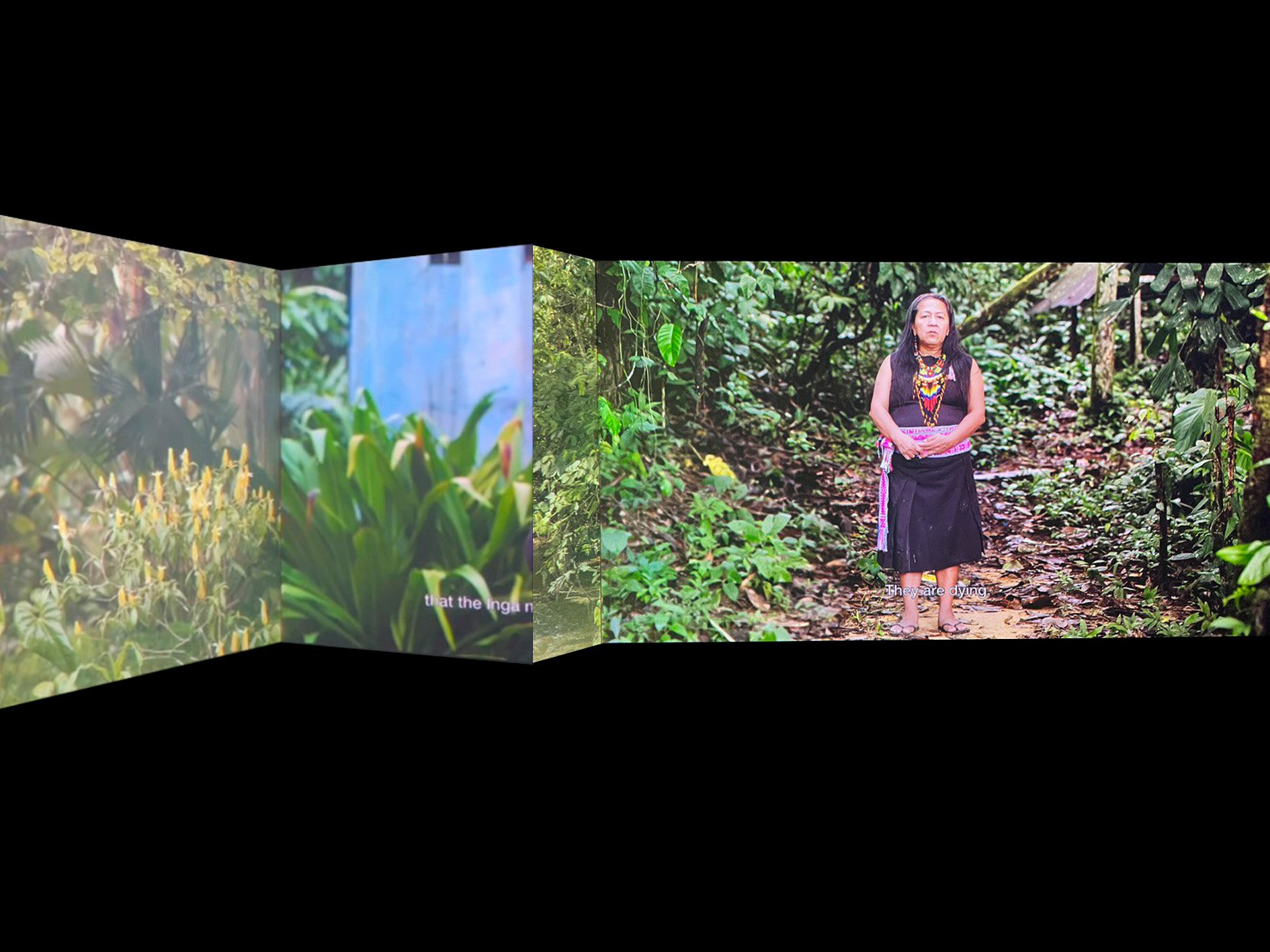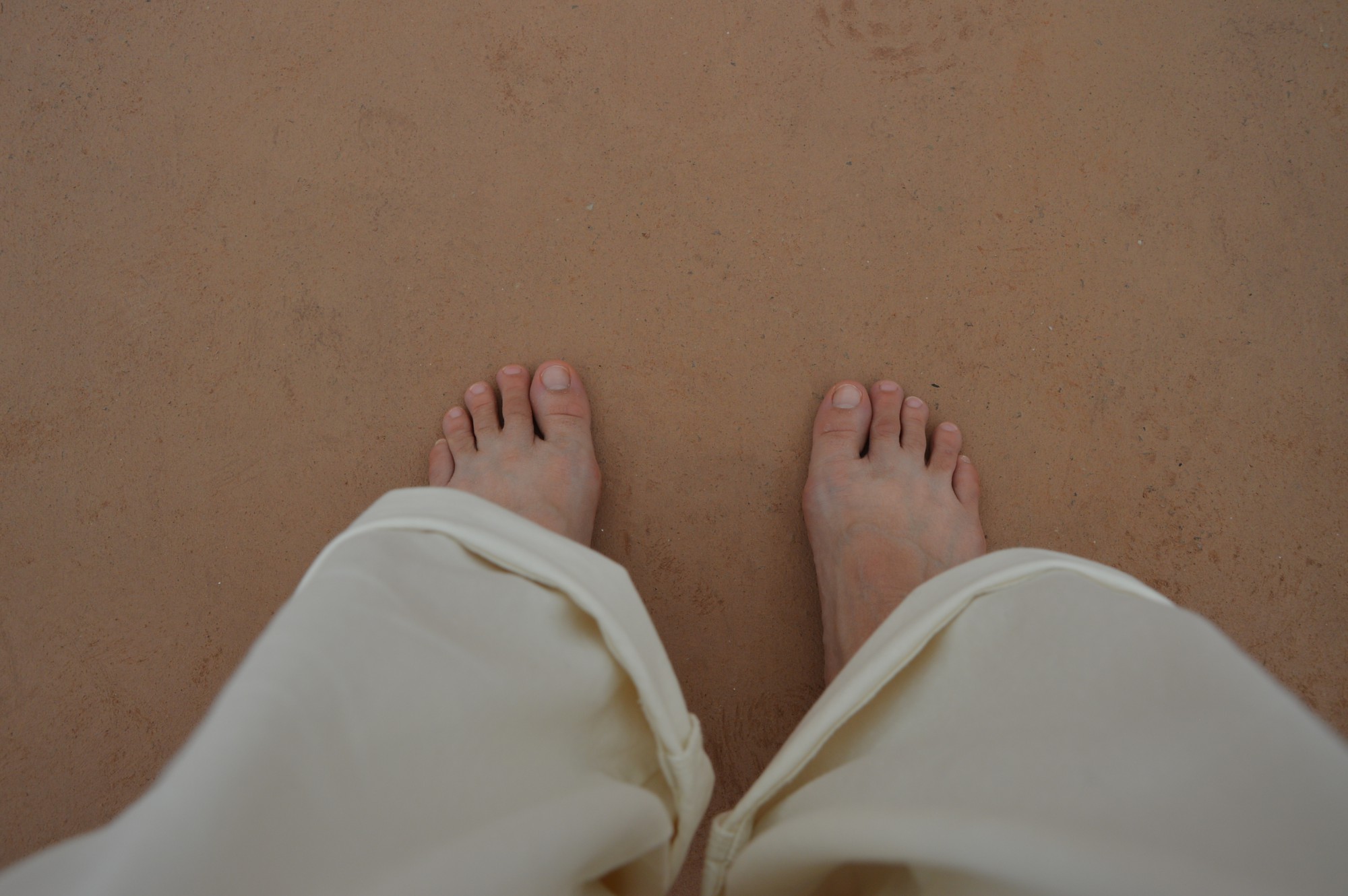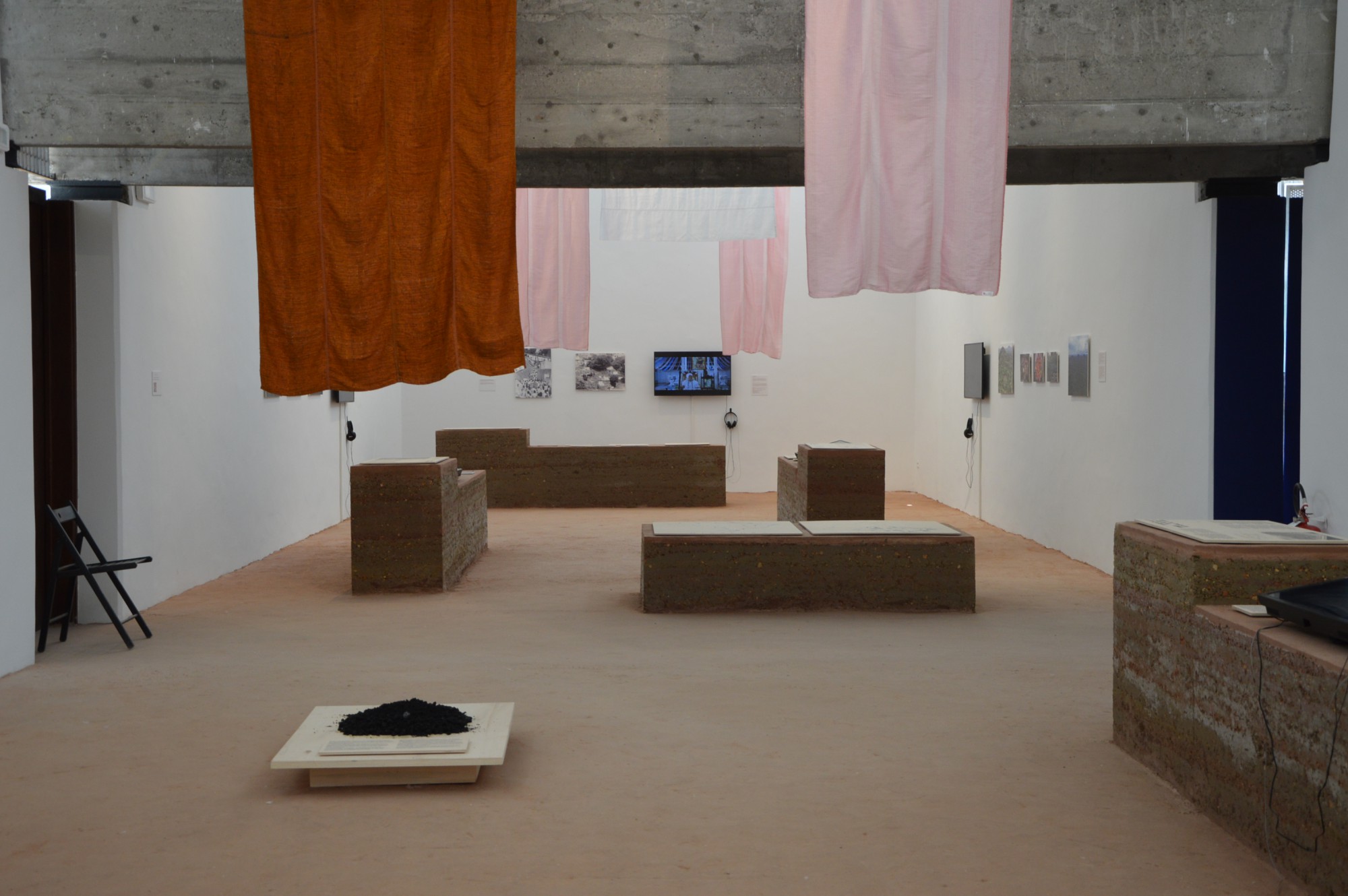Field Notes from the Pluriversity: Reflections on the 18th Venice Architecture Biennale
In order to understand it, I needed to cross itClarisse Figueiredo de Queiroz
In order to understand it, I needed to cross itClarisse Figueiredo de Queiroz
As soon as I closed the door, I realized I had forgotten my phone inside the apartment. At that point, our AirBNB key had already crossed the Venetian Lagoon from Lido to the Giardini, nestled inside Yidan's pocket. It was the first Sunday of the 18th Venice Architecture Biennale, and I was about to explore the city without a watch, a map, or communication—just movement, wonder, and waiting.
After taking the next ferry and arriving at the Arsenale, I crossed the suspended atmosphere of Lesley Lokko's “Blue Hour” until I reached Dangerous Liaisons. Halfway down the Corderie, a corridor on the left suggested a detour. At the end of this detour, there was a river: two enormous screens flooded a dark room with images of the Caquetá River in Ursula Biemann’s video installation “Devenir Universidad” (“Becoming University”). Without any timekeeping device, I lost track of how many minutes I remained there watching the Inga people discuss the need to invent a new word for what we understand as a university, about the need to create a science desde el Sul—from the South. How do we inhabit legacies?
As I felt this question slowly emerging in my mind, I remembered an account I had read long ago. In his essay, “Incendiador de Caminhos” (“The Path Burner”), Mozambican writer Mia Couto tells a travel story. Once, called to investigate “uncontrolled" wildfires in the African savannah, Couto encountered an “ecology of fire.”Mia Couto, “Incendiador de Caminhos,” in E se Obama fosse Africano?: e outras intervenções (São Paulo: Companhia das Letras, 2016). To understand the reasons behind the fires, he needed to walk. In this movement, the writer met what he called the “visitor man.” For rural Mozambican families, the task of walking, of blazing trails with fire, appeared as one of the central activities in conflict prevention and the building of bonds in a geographically dispersed society:
The visitors spend most of their time in welcome and farewell rituals. Opening the doors of a place requires agreements with the ancestors who are the only true ‘owners’ of each of these places. The visiting men cover unbelievable distances on foot. As they progress, they set fire to the grass. Unless it's in the middle of winter, this grass burns little. The fire spreads and fades in the vicinity of the path that travelers are following. This fire provides various services and advantages that become clear upon their return: it defines a reference map, keeps snakes and ambush dangers at bay, makes the terrain easier to traverse, and ensures a safer journey back.Couto, 69–76. Translated by author.
This narrative reminds us that there is a form of knowledge created through movement, a nomadic episteme that advances through experience, growing as we give names to things, with each name encompassing an entire story.

In Biemann’s video installation, we witness the collaborative process of co-creating an indigenous university in the Colombian Amazon through a series of interviews with representatives of the Inga people. This process involves elders, taitas (traditional medics), mamas (healers), educators, and community leaders.
“Devenir Universidad” displays how, for the Inga people, learning occurs through their observation of the weather, their interactions with animals, mineral deposits, plants, rivers, and during walks through the páramos and forests. Thus, in a decentralized network, paths and stories intersect, weaving together a tapestry of “river-learning, forest-learning, chagra-learning,”Ursula Biemann, “Devenir Universidad,” KoozArch, January 06, 2023. and multispecies research. Biemann says,
The elders spoke of a great territory. And that great territory, they always walked it. Frequently. When it was not to go fishing, it was to bring animals, to bring quinine, many plants that are used for traditional medicine, for handicrafts, for timber for our houses.Doris Waira Jacanamijoy, Vocal Cognitive Territory (2021), video, 1:44 - 2:40, https://vimeo.com/852103178.
Indigenous communities have been walking and getting to know their territories for millennia in a movement of biological and epistemic co-evolution. This living knowledge, like an organism, involves human minds and more-than-human entities. This bioculture—a term that merges nature and culture, rather than dyadically opposing them—accumulates in bodies, in the land, and in oral traditions. It transforms and expands as it moves. When an elder passes away, or when a species of plant or animal goes extinct, a part of this ancestral knowledge is lost. In this context,
What is becoming University is not primarily the Inga people but the territory itself…. Knowing something means becoming part of a field of meaningful relations with all species and with the social and historical relations connected to that space. This complex field of ecological relations is what indigenous people in Amazonia call territory, it is intimately connected to knowledge, wisdom, perceiving and caring. In this sense, we project a real territorial university, collectively processing the ever-changing interactions between the different entities involved in meaning and world-making.Biemann, “Devenir Universidad.”
This institution, this university mentioned above, is still in development. It does not intend to be static but roams through various empirical and subjective territories, igniting paths. Above all, it challenges established knowledge systems that rely on classificatory, hierarchical, and Cartesian processes. Particularly, those that, in Biemann’s words, have been established as “the only verifiable truth” and holders of “premises of objectivity,” such as modern science and Western thought.“With modern science establishing itself as the only verifiable truth, the Indigenous communities have been put into a vulnerable position not only by colonial conquest and its disowning practices, but also by modern western science and its premises of objectivity;” Biemann.
To create an institution that challenges colonial truths, a new name must be coined. In “Devenir Universidade,” we see Hernando Chindoy, a spokesperson of the Indigenous Inga People of Colombia, stating: “For now, to be a little more comprehensible, the message in terms of what is there, I am going to say that it is a University. Later on, you can say that it is a Pluriversity, an Ayachayuhuasi, for example, whatever.”
For whom do we name and what is the extent of a name’s utility? According to anthropologist Tim Ingold, to be alive is to be in movement, knowing, and describing, in a state of attention to and within the world.Tim Ingold, Being Alive: Essays on Movement, Knowledge and Description (London: Routledge, 2011): 158. The act of naming, therefore, becomes essential in the survival of the being who, by elaborating knowledge through movement, cognitively shapes their world.
“I am going to say that it is a University,” Chindoy said as a concession. When we place the cosmology of non-Western knowledge in the face of everything categorized, classified, scientifically proven in accordance with Western paradigms, we catch a glimpse of the abyss between these worlds. In another part of the video, when discussing disputes over Amazonian biodiversity, Doris Jacanamijoy lets slip that, “we didn't name it in scientific terms, but we did know the richness of the fauna and flora.” Things can have many different names.
In a conversation included in the book Black Sun: Alchemy, Diaspora and Heterotopia, artist Shezad Dawood and writer Kodwo Eshun share thoughts on the word diaspora, on hermeticism and discovery, on mystery and decoding.Shezad Dawood, “Kodwo Eshun, Shezad Dawood & Gerrie Van Noord in Conversation,” in Black Sun: Alchemy, Diaspora and Heterotopia (London: Ridinghouse in association with Devi Art Foundation and Arnolfini, 2013): 81-97. Here, I understand the diasporic figure as all bodies that set themselves in motion and engage in dialogue with bodies that encompass hegemonic languages and performances, encompassing not only the Inga people in communication with knowledge and ways of thinking embodied by Anglo-Saxon and Western bodies but also immigrant bodies passing through historically colonizing territories. When we talk about decolonial and ancestral knowledge and about a science desde el Sul, we also need to also talk about translatability. According to Eshun, the diasporic figure is always calculating how much they need, or rather, how much it is worth translating to be understood:
Even if you translated it, they wouldn’t understand. At a certain point you understand this and that decision contains this hidden reserve of non-translatable knowledge. So there's a certain discrepant quality that diasporic subjectivity finds itself in. This decision to withdraw some knowledge from translatability, to withdraw it from an encounter, I'd say is where a certain hermeticism starts to become important. Then when you talk about it aesthetically, you can see it's in all kinds of works as a continuous making public of that which is hidden. So for a lot of work, it's like an open secret, a series of signals and codes which are there on the surface but that pass. The diasporic figure is always struck by how uncurious the host nation is. We have these signals and symbols we put right out there. Nobody asks you about them. But when they ask, you can't explain them anyway. So there's a hermeticism, which is generated out of the very process of untranslatability. The aesthetic question is how you shape that. How you shape that withdrawal, which you are making public.Dawood.
Once more, we can see a concession.
Hernando Chindoy precisely captures this untranslatability when he says, “but for now, to be a little more comprehensible… I can say that it is a University.” This is further illustrated in another passage: When Doris Waira Jacanamijoy expresses her fear of the extinction of indigenous cultures in the face of the loss of ancestral languages and ideologies, she attributes the cause to the fact that the Inga people, as a collective, are no longer thinking about a philosophy of the environment desde el Sul, in a territory desde el Sul, or an Ambihuasca desde el Sul. The English translation omits the expression “desde el Sul” all three times.
Repetition is crucial for linguistic performance. There is valuable information held within repetition, creating a well-trodden path as we pass through it multiple times. Reflecting on the questions that stayed with me that day: How do we inhabit legacies? We repeat them.

Departing from the Arsenale towards the Giardini, undertaking my erratic movement, I arrived at the Brazilian Pavilion.
Upon entering the building, I took off my shoes to better sense the moisture on the red earth floor, originally designed by Henrique Mindlin in 1964. The soil invaded my lungs, stained my white clothes, and hid between the toes of my feet.
The “aterramento” (landing, grounding) proposed by curators Gabriela de Matos and Paulo Tavares goes beyond simply filling the floor of a modernist building with soil. In fact, the word, aterramento, can be used in many contexts. Sometimes, it refers to the system of electrical current interference, whose resistance depends directly on the composition, moisture, and temperature of the soil in which this system is installed. Other times, it refers to meditative, spiritual, magical, and ritualistic practices. In all cases, there is an invocation of a movement in which a specific type of energy finds its way to the ground.
Before grounding the Brazilian Pavilion, it was first necessary to protect it. In photographs of the preparation of the pavilion's floor, Daniela Elston, “Abre, Neste Sábado (20), O Pavilhão Do Brasil Na 18a Mostra Internacional de Arquitetura - La Biennale Di Venezia,” Revista PROJETO, May 19, 2023. I observed with curiosity that the ojá and alaká fabrics—integral parts of the exhibition—were already hanging before the floor’s completion. They were likely the first pieces to be installed. While alaká is a fabric that evokes social and religious meanings, ojá, in turn, serves to protect and beautify humans, drums, trees, and deities.“Lugares de Origem, Arqueologias Do Futuro: Pavilhão ‘Terra’ Do Brasil Na Bienal de Veneza,” ArchDaily Brasil, July 2, 2023. https://www.archdaily.com.br/br/1002026/lugares-de-origem-arquelogias-do-futuro-pavilhao-terra-do-brasil-na-bienal-de-veneza.

Protective rituals appeared to be present throughout the conception, production, and installation process of the Brazilian Pavilion. The spiritual dimension influenced and resonated in the space as much as maps and architectural drawings. Ayrson Heráclito's performance, “Places of Origin, Archaeologies of the Future,” is present in the pavilion’s second gallery. In this mesmerizing display, the artist purges two architectural monuments linked to the enslavement of people in Africa and Brazilian colonization. His ritualized sacudimento (shaking) exorcizes domestic environments by smudging sacred leaves throughout the building, thus dispelling the spirits and eguns. Here, the ritual is as much a part of architecture as painting a wall or getting rid of construction dust.
During the opening of the pavilion, the Brazilian Minister of Culture, Margareth Menezes, recited a passage from a song as if it were a prayer: “Walk, I want to tell you no secret / I'm talking about the ground of our house / Come, it's time to tidy up.” Walk, the first word spoken, a call to movement. A song-prayer that serves as an omen. Come, a request to return home, to the origin of all things. It is only by returning to the ground of our home, the land of the original territories, that we can organize, plan, and, finally, move forward.
The two installations I visited that Sunday encompassed an understanding of space as collectively constructed and filled with ancestral and ritual teachings. Both ignited paths, created new names, understood Indigenous knowledge as a contemporary spatial practice, and recreated images, stories, memories, heritages, and architectures. Both the Brazilian Pavilion and “Devenir Universidad” proposed a disruption of this system, possible detours, like the corridor that led me to the Caquetá River in the middle of Venice.
Every laboratory is a place of experimentation in which knowledge is shaped through tests, successive attempts, training, and constant movement. A biennale, as an experiment, evolves as it invents itself. In this iteration of the Venice Architecture Biennale, wandering and moving through it was the method to consider ancestralities as a way to envision the future.